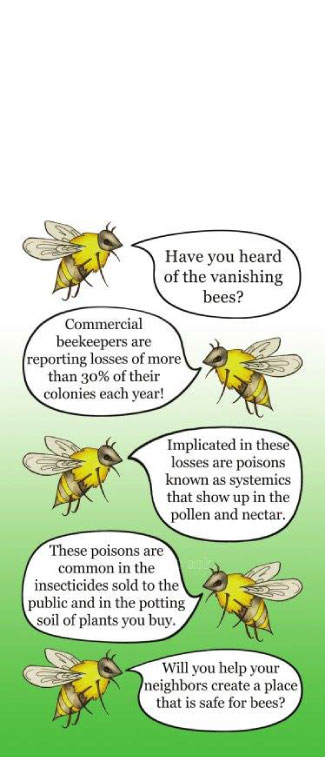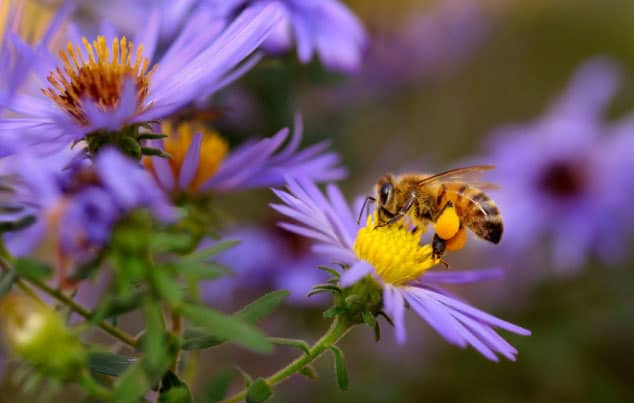By Donald Studinski, based on original text by David Braden, Director of Living Systems Institute
Living Systems Institute (LSI), a non-profit operating in Golden, Colorado, and Honeybee Keep, a commercial beekeeping business operating in Broomfield, Colorado, have joined forces to sponsor the Bee Safe Neighborhoods program.
We pose this question: “Do you want a healthy habitat or a sterile habitat?”
When we use a poison to eliminate a particular species from our yards, we must face a series of consequences. One is the collateral damage from the poison. That is, all the non-target bugs that come into direct contact with the poison and die unintentionally. Another is the negative impact on the species that rely on the targeted species: by eliminating the one, we deplete a food source of the other. And because those species now have nothing to eat, they go elsewhere—as do all the species that rely on those species for their food source. Eliminating a single species is the first step on a path that, if followed to its logical conclusion, turns a healthy habitat into a sterile system. The end result is a hospital-like environment. In hospitals the only things that grow are super bugs that cannot be killed by known technology.

Unlike the sterile environment you find in hospitals, the most beautiful places you’ve ever been are healthy ecosystems. They are healthy because they contain a full range of participating species. Each one is allowed to give its gift and play its role.
There’s a disputable argument to be made that if we are to feed the world’s human population, we need a monoculture—growing food in huge acreages of a single crop. To those who make such claims, poisons are necessary to protect these huge crops from pests. But when that argument is put in practice, it leads to huge acreages of sterile crop lands where nothing grows except the species that are resistant to the poisons.
We cannot justify such behavior in a suburban landscape. Our yards and gardens are polycultures, and we have space for all the species, both pests and the eaters of those pests. By allowing all the species to participate, we foster the creation of a healthy habitat. And because the habitat is healthy, it’s also beautiful.
For example, when we poison the aphids on our roses, we prevent lady beetles from participating in our garden, leading in the direction of a sterile system. On the other hand, when we think of aphids as food for the lady beetles, our garden starts to regain its health. A healthy system needs all its parts. In this example, that includes roses, aphids, and lady beetles.
This is your habitat. Do you want it to be sterile or healthy? If your answer is healthy, start by taking responsibility for it. Begin with what you have control over, and move on to where you have influence. That’s what the Bee Safe Neighborhood proposal is about. First, stop using poisons. Then consider holding a neighborhood meeting or gathering where you can offer educational materials from LSI and talk about the benefits and intentions of a Bee Safe Neighborhood. Recruit some like-minded people to help you canvass your neighborhood. Spread out and talk to your neighbors with informational cards and door hangers.
Someone will have to talk to the neighbor down the street who is using poisons, or hiring people to use poisons, while thinking them safe. Such a conversation cannot wait for some environmental activist or politician to take the initiative. It’s up to you. Your neighbor believes that the poison is necessary to protect their investment in their plants. Marketing has convinced them of this. They don’t realize that they’re damaging the health of the habitat. Ask them to commit to not using systemic poisons. If that conversation does not take place, the damage will continue to lead in the direction of a hospital environment. Most people will at least hear out a neighbor. The encounter need not be confrontational. Just ask if they’ve heard about the vanishing bees. The conversation will essentially be like the one on the door hanger developed by LSI. Even the most committed user of poisons understands the need for pollinators. And if they don’t agree to quit using systemic poisons right away, they can watch as you demonstrate how beautiful a healthy system can be. Those who’ve been out there canvassing report a mostly positive response from their neighbors, and LSI has reported some success in the form of an “Honor Roll” of Bee Safe Neighborhoods.
This is about changing the standard for landscaping in our habitat. We know it’s possible because we know that people prefer beautiful places to hospitals. But someone has to start that conversation.
LSI will certify neighborhoods as bee safe if 75 contiguous homes pledge to not use systemic poisons. A honey bee will regularly fly two miles to visit a flower. In that area 75 contiguous homes is a relatively small patch of healthy habitat, but it’s an important step in creating larger healthy habitats.
Why 75 contiguous homes? It has to do with the way humans work. Scientific research backs up a theory known as Dunbar’s number, which shows that humans are genetically programmed to want to work together for the common good within groups of 150 people or less. This number roughly represents about 75 adjacent houses. In other words, a neighborhood—one that works together to improve its habitat. And that’s what the bees need. It’s what we all need if we want to live in a healthy habitat.
If the bees can provide inspiration for us to improve our habitat, then everything wins. Healthy habitats are good for the bees, good for our children, good for our pets, good for all the species that participate in it, and good for us. As a side benefit, people who get involved in a Bee Safe Neighborhood also get the chance to talk with each other, building new relationships that have the potential to lead to more good things.
You can form your own Bee Safe Neighborhood. People are doing it all over the USA. Learn more about the Bee Safe Neighborhood program by visiting LivingSystemsInst.org. There you’ll find resources to help you and other kindred spirits who are forming neighborhoods that are Bee Safe.
Photo from iStock/LightShaper


